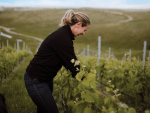New Frontiers – Q&A
Bragato Research Institute Chief Executive MJ Loza has had a busy 18 months, helping drive the establishment and development of the national wine research centre, based in Blenheim.
Ensconced in an annex next to an unruly shed of tanks and barrels in Alexandra, it doesn't look much like French winemaker Antony Worch is living the dream. But I suggest you don't tell him that.
Having moved nearly as far in the world as it's possible to go from Alsace and his beloved Riesling, Worch can't stop smiling about the way his career is panning out, and the faith put in him by a small group of Alexandra vineyards. He is now the winemaker-manager at Alexandra Vintners.
To understand a little bit about what drives him, its handy to know a little bit of Worch's backstory and how he found his way to Alexandra. After finishing his Masters in winemaking and viticulture in 2005, Worch and his partner Marion Vialade picked up a map and decided to complete a vintage abroad.
"If you look at the options on places we could go in the Southern Hemisphere, you have South America, South Africa, Australia and New Zealand. I don't speak Spanish and where we are from its closer to German-Nordic type of culture rather than a Mediterranean one, so South America wasn't my first choice."
Tempted by images of New Zealand, they decided to give it a go. But as they had little information about our wine and where to base themselves, they decided to check with some other graduates who had already completed vintages here.
"Back then the only information we could find tended to start and finish with Marlborough and Sauvignon Blanc," says Worch.
After doing some more investigation and hearing about Central Otago, Worch figured that if nothing else, the area offered a climate that the couple were keen on, along with varieties they were familiar with.
Arriving in time for the 2005 harvest, Worch landed a job at Peregrine and Marion at William Hill in Alexandra. It was here the couple's fate was marked.
During 2006 the existing winemaker at William Hill had to resign due to US commitments and there was no winemaker on board for 2007.
"We didn't have that much experience, but the departing winemaker offered to put in a good word for us with the owners. This was a great opportunity and we had to make a decision, but we didn't think very long about it."
The role at William Hill was great preparation for the couple's current work. With a fair percentage of contract winemaking processed through the winery, the work meant that they wouldn't be just working with Alexandra fruit. But even as they were starting to get to grips with the sub-region variables, storm clouds were brewing. In June of 2009 William Hill went into receivership.
"Some of the clients who had been working with William Hill came to me and said 'What is going to happen to us'?
" To be honest," says Worch, "I wasn't even sure what receivership meant".
The Alexandra basin is populated by smaller players in the industry, family vineyards that often struggle for recognition within the wider Central Otago region. For many vineyards in the district, their wine was made at William Hill, but when the receivers took over that arrangement was suddenly blown apart.
Making a bold decision to try and keep their grapes close to home, four Alexandra based wineries (Aravin, Drumsara, Greylands Ridge, Perseverance) banded together to form Alexandra Vintners. Having formed a relationship where the clients were very happy with the way Antony and Marion were making their wine, a deal was struck with the receivers so that the 2010 vintage could still take place at the William Hill winery.
But as they were on borrowed time, long-term decisions had to be made fast.
"Marion and I were 30, we had spent the last five years travelling back and forward to France between vintages, and we wanted to settle a bit more. So, it was really fortunate that those vineyards decided to go it alone with us."
Thus, Alexandra Vintners was born, and after finding a vacant shed in an industrial complex, plans for the 2011 vintage started to take place. Antony actually talks about the process being pretty straight forward, but after chatting for a bit you soon appreciate there was a little more to it.
"We came back in January 2011 and we had about two months to finish last year's wine and be ready for harvest.
"There was a lot of excitement and quite a bit of fear as it was just a shed to start with. We actually had help from the people around us, certainly to take care of the business side of things, but being young I guess it was okay to be a little bit crazy."
After the initial teething process, there was a fair amount of curiosity from other vineyards in the region keen to see how they performed. Even though some saw it as a gamble to trust their grapes to the new facility, the reality was quite different.
After successfully processing 110 tonnes that first year, momentum at the newly established facility kicked up a gear in 2012. With three new clients and some contract grapes, production increased to 170 tonnes. In 2013 they reached 200 tonnes and in 2014 it topped out at 250 tonnes. For 2015, production was pegged back to 220 tonnes.
"That is a bit of sweet spot for us", says Worch, "it still allows me some time to spend outside in the vineyards."
Having been here for 10 years now and well and truly part of the fabric of the Central Otago winemaking community, Worch has an interesting perspective when it comes to the evolution of wine in that time.
"When we first came to the region everyone was trying to construct their Pinots, extract more and make them as big as possible, it was all about getting on the map and making a statement," he says.
"But you know what... and I don't want to offend anyone here, but if you go to the supermarket and get a $12 Shiraz from South Australia, you'll get the tannins and purple tongue for much greater value.
"Fortunately, I think we are no longer trying to achieve that particular style, we know we have great grapes and I am noticing that people are more confident in what they have and they are able to pull back a little bit and let the fruit express itself."
Throughout the year, Antony is employed full-time by the facility while Marion works as a printmaker and looks after their three-year-old son.
The team swells to seven during vintage, but the long-term goal is not to boost the volume or size of production from where they have it now.

OPINION: Harvest begins, and almost immediately we start to get media enquiries about how the vintage is going and whether it…

OPINION: Rachael Cook is the smiling grape grower on this month’s cover, tending vines on the miniscule, beautiful and dream-driven vineyard…
New Zealand wine enthusiasts have a deepening understanding and growing appreciation of sparkling wine, says Mel Skinner, Chair of Méthode Marlborough…
One of the biggest mistakes wine marketers make is in assuming consumers are as passionate and knowledgeable about wine as…
Taking two sustainability awards at two events on a single evening felt like "true recognition" of the work Lawson's Dry…